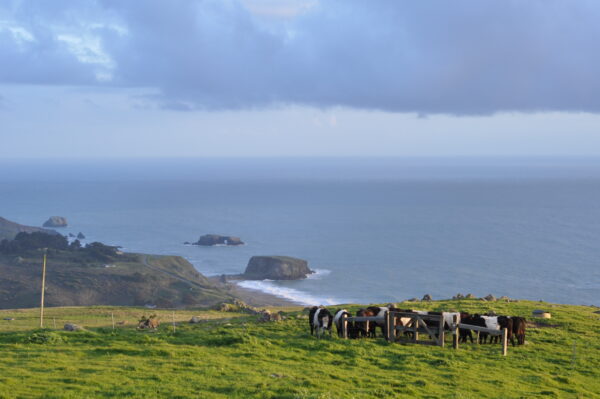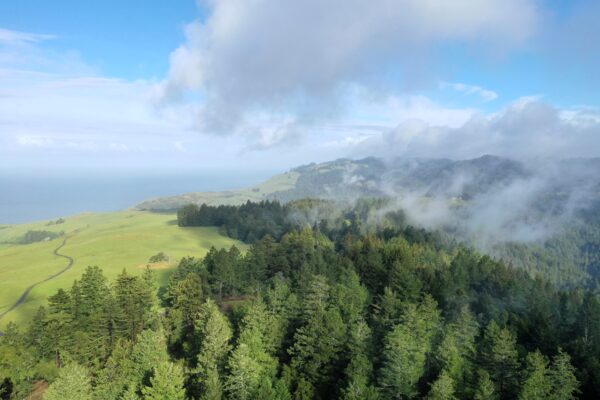February 10, 2025
Posted in: News Articles
Jenner Headlands Preserve is a stunner – with over 5,600 acres of coastal prairie, oak and redwood forests, and views that truly awe and inspire. Running for 2.5 miles along the Pacific Coast Highway, the Headlands is part of the historical lands of the Kashia Band of Pomo Indians, and is today owned and managed by The Wildlands Conservancy with support from Sonoma Land Trust and Ag + Open Space. Ag + Open Space holds a conservation easement over the preserve, and contributed over $9M to its purchase and conservation. We recently got a chance to chat with the preserve manager, Ryan Berger, to learn more about how this publicly-accessible preserve is being cared for and enjoyed.
As Ryan shared, Jenner Headlands is currently managed under an integrated resource management plan that was developed by partnering with a broad array of experts who helped plan out how to best care for the land. To develop these plans, you first survey to see the current status of the property. As Ryan said, “History speaks for itself… as this area was settled and logged, the land was damaged. Now we have to heal past scars, and we’re working to do that in a collaborative way with community members, partners, and so on.”
When Ag + Open Space holds a conservation easement over a property, it is our responsibility to work with the landowners and support them in planning how to care for the land. We do this by helping to interpret the easement, and supporting landowners when they have land use questions – like identifying wildlife-friendly fencing options or reviewing forest management plans. As part of the Headlands’ management plan, there are projects focused on the grasslands, riparian areas and water resources, and forests. The Conservancy also sees the preserve as somewhat of a demonstration location, where they can have the preserve open while projects are happening, so visitors can see land management in action.
- Credit: The Wildlands Conservancy
- Credit: The Wildlands Conservancy
For vegetation management, projects have been aimed at upgrading the grazing operations so that they are more efficient and evenly spread across the preserve. By working with Markegard Family Grass-Fed, the Conservancy has been able to replace old fencing with wildlife-friendly cross fencing, and developed more pastures with water systems so that the cattle can be rotated. This grazing rotation helps to ensure that vegetation is evenly and consistently managed, which in turn means that native plants are able to flourish while also removing vegetation that could act as fuel during a wildfire. Looking ahead, they’ll be working with the Coastal Conservancy to extend grazing towards Pole Mountain.
And in connecting back to past land uses, the Conservancy has done an immense amount of work to bring the forests on the property back into a healthy, thriving state, while also working to make the land more resilient in the face of wildfires. Through shaded fuel breaks, which increase the spacing between trees by reducing the amount of small plants and trees in between, and additional timber harvest projects, the forests have been transformed from overcrowded to being more balanced.
When forests are overcrowded, the plants are competing for resources. And as Ryan explained further, “Here I find a gardening analogy is helpful. When you plant a row of carrots, they often end up overcrowded and you have to remove some so that others can grow to the desired size.”

Credit: The Wildlands Conservancy
Learning from and working with the Kashia has also been a critical piece of the Conservancy’s work. As Ryan noted, over history we moved away from the sustainable practices of the Kashia, like burning and other fuels reduction, and we’re now trying to build a future where those practices return.
All in all, talking with Ryan was an excellent reminder of how land conservation is a collaborative endeavor. And how special for all of this work to happen on a property that is open to all to visit. If you want to learn more about the Headlands, you can visit WildlandsConservancy.org, or even better… visit! The preserve is free to visit every day, 8am to sunset and their free programs, volunteer opportunities and calendar of guided hikes can be found here: https://wildlandsconservancy.org/preserves/jennerheadlands/publicprograms

